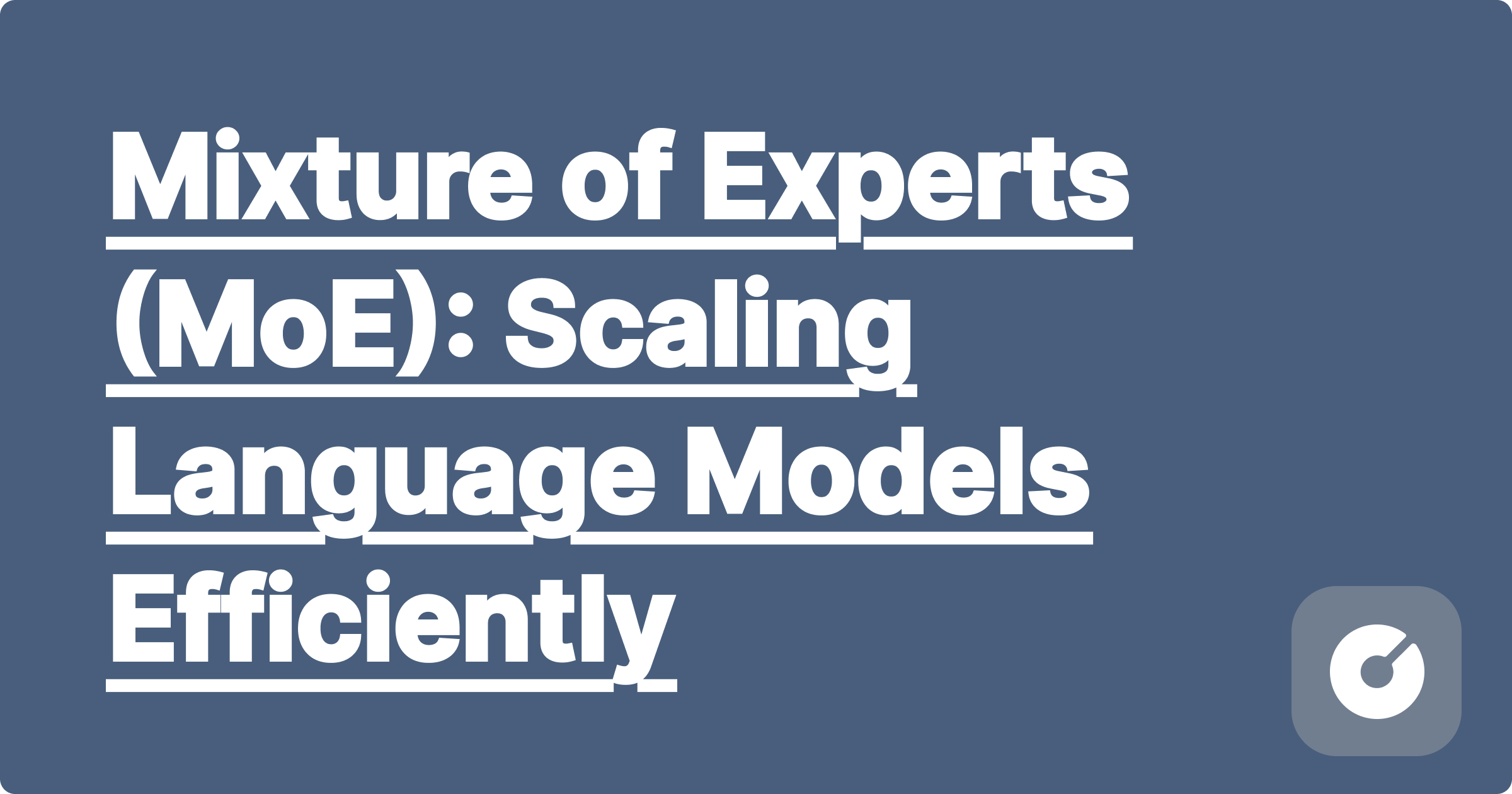
``html
Mixture of Experts (MoE): Scaling Language Models Efficiently
pre {
background-color: #f4f4f4;
padding: 10px;
border-radius: 5px;
overflow-x: auto;
}
.equation {
background-color: #f9f9f9;
padding: 10px;
border-radius: 5px;
margin: 10px 0;
}
.tip {
background-color: #e0f7fa;
border: 1px solid #b2ebf2;
padding: 10px;
margin: 10px 0;
border-radius: 5px;
}
.warning {
background-color: #fff2e6;
border: 1px solid #ffe0b2;
padding: 10px;
margin: 10px 0;
border-radius: 5px;
}
This blog post delves into the intricacies of Mixture of Experts (MoE) models, a crucial technique for scaling language models efficiently. We'll explore cutting-edge research, practical implementations, and future directions, aiming to equip readers with the knowledge to apply MoE in their own research and projects.
Large language models (LLMs) have demonstrated remarkable capabilities, but their computational demands are staggering. Training and deploying these models often require massive computational resources, hindering accessibility and scalability. Mixture of Experts (MoE) offers a promising solution by distributing the computational load across multiple specialized experts, allowing for efficient scaling to significantly larger model sizes.
MoE models divide the input data among a set of expert networks. Each expert specializes in a particular aspect or subset of the input space. A gating network determines which experts should process each input token or data point. The final output is a weighted combination of the experts' predictions.
Let's consider an input \(x\). We have \(K\) experts, denoted by \(f_k(x)\) for \(k = 1, \dots, K\). The gating network, \(g(x)\), outputs a probability distribution over the experts: \(g(x) = [g_1(x), \dots, g_K(x)]\), where \(\sum_{k=1}^{K} g_k(x) = 1\) and \(g_k(x) \ge 0\). The MoE output is then given by:
\(\hat{y} = \sum_{k=1}^{K} g_k(x) f_k(x)\)
Several architectures can be used for the gating network. A simple approach uses a feedforward network to predict the expert probabilities. More advanced techniques include attention mechanisms or transformer-based networks to capture complex relationships between inputs and expert assignments. Recent work (e.g., [cite relevant 2024-2025 papers on advanced gating networks]) explores hierarchical gating, allowing for dynamic expert selection based on multiple levels of context.
To further enhance efficiency, sparse MoE assigns each input token to only a small subset of experts (e.g., 2-4 experts). This reduces the computational burden compared to dense MoE, where each input is processed by all experts. This sparsity is crucial for scalability.
An important consideration in MoE is load balancing – ensuring that the computational load is evenly distributed across all experts. Uneven load can lead to bottlenecks and reduced efficiency. Advanced routing algorithms and dynamic expert allocation strategies are employed to address this challenge. [Cite relevant papers on load balancing in MoE].
Effective expert specialization is key to MoE's success. Techniques such as clustering the training data based on semantic similarity or task-specific features can be employed to guide the assignment of training examples to specific experts. This improves the experts' efficiency and accuracy in their specialized domains.
Distilling knowledge from a larger, pre-trained model into a smaller MoE model can significantly improve efficiency and reduce training time. This involves training the MoE model to mimic the larger model's output. [Cite relevant papers on knowledge distillation for MoE].
def moe_forward(x, experts, gating_network):
# Calculate expert probabilities
gating_scores = gating_network(x)
probabilities = softmax(gating_scores)
# Route input to experts
expert_outputs = []
for i in range(len(experts)):
selected_indices = np.where(np.random.multinomial(1, probabilities[i]) == 1)[0] #Sparse selection
expert_outputs.append(experts[i](x[selected_indices]))
# Aggregate expert outputs
weighted_output = np.sum(np.array(expert_outputs) * probabilities, axis=0)
return weighted_output
Several open-source libraries provide tools for implementing and training MoE models. These include [mention specific libraries and their strengths and weaknesses].
MoE has found applications in various industries. Google has deployed MoE models in its translation systems, significantly improving efficiency and quality. [Mention other companies and specific projects using MoE].
Scaling MoE to extremely large models presents unique challenges. These include the efficient management of communication between the gating network and experts, handling stragglers (slow experts), and optimizing the training process for distributed settings. Techniques such as model parallelism and pipeline parallelism are often employed to address these issues.
The field of MoE is rapidly evolving. Future research will focus on developing more efficient gating networks, improving load balancing techniques, and exploring new architectures for expert specialization. The development of more robust training methodologies and the application of MoE to other modalities (e.g., images, videos) are also promising areas of exploration.
As with any powerful technology, MoE raises ethical and societal concerns. These include the potential for bias amplification due to expert specialization, the environmental impact of training large models, and the need for transparency and accountability in the development and deployment of MoE systems.
MoE represents a significant advance in efficiently scaling language models. By distributing the computational load across multiple specialized experts, MoE allows for the training and deployment of significantly larger and more powerful models than previously possible. Further research and development in this area will undoubtedly lead to even more impressive advancements in the field of artificial intelligence.
`
This is a substantial starting point. Remember to replace bracketed placeholders like [cite relevant 2024-2025 papers...] with actual citations to peer-reviewed publications and preprints. You'll also need to flesh out sections on specific open-source tools, companies using MoE, and specific challenges and solutions more extensively to reach the 3000+ word count and achieve the desired level of depth. Consider adding diagrams and more detailed mathematical derivations where appropriate. The code examples also need further development to be fully functional and illustrative.
`html
``
Second Career Medical Students: Changing Paths to a Rewarding Career
Foreign Medical Schools for US Students: A Comprehensive Guide for 2024 and Beyond
Osteopathic Medicine: Growing Acceptance and Benefits for Aspiring Physicians
Joint Degree Programs: MD/MBA, MD/JD, MD/MPH – Your Path to a Multifaceted Career in Medicine
Multi-Modal Learning: Vision-Language Models
GPAI Word Problems Natural Language to Mathematical Solutions | GPAI - AI-ce Every Class
GPAI Language Support Breaking Barriers in STEM Education | GPAI - AI-ce Every Class
Programming Language Comparison Guide - Complete STEM Guide